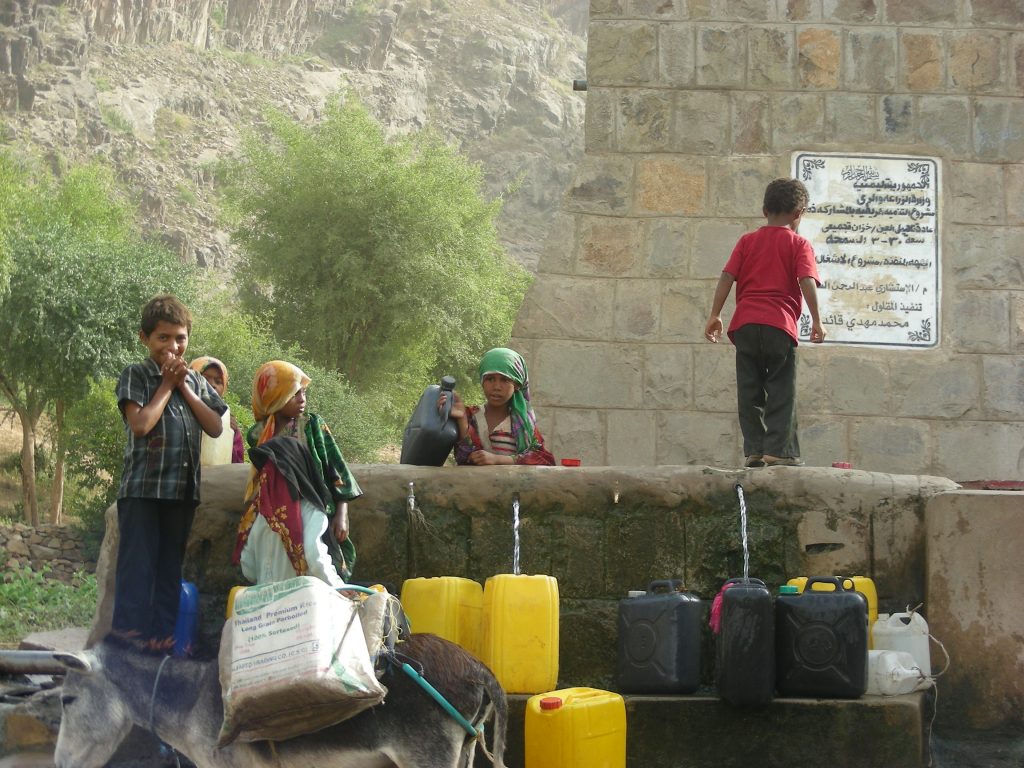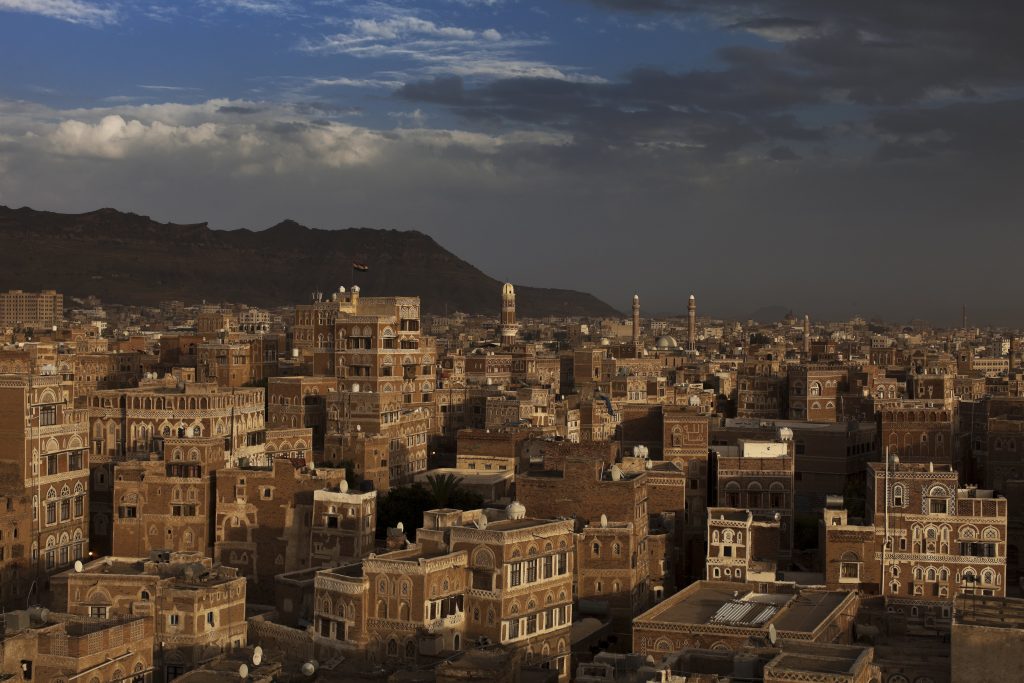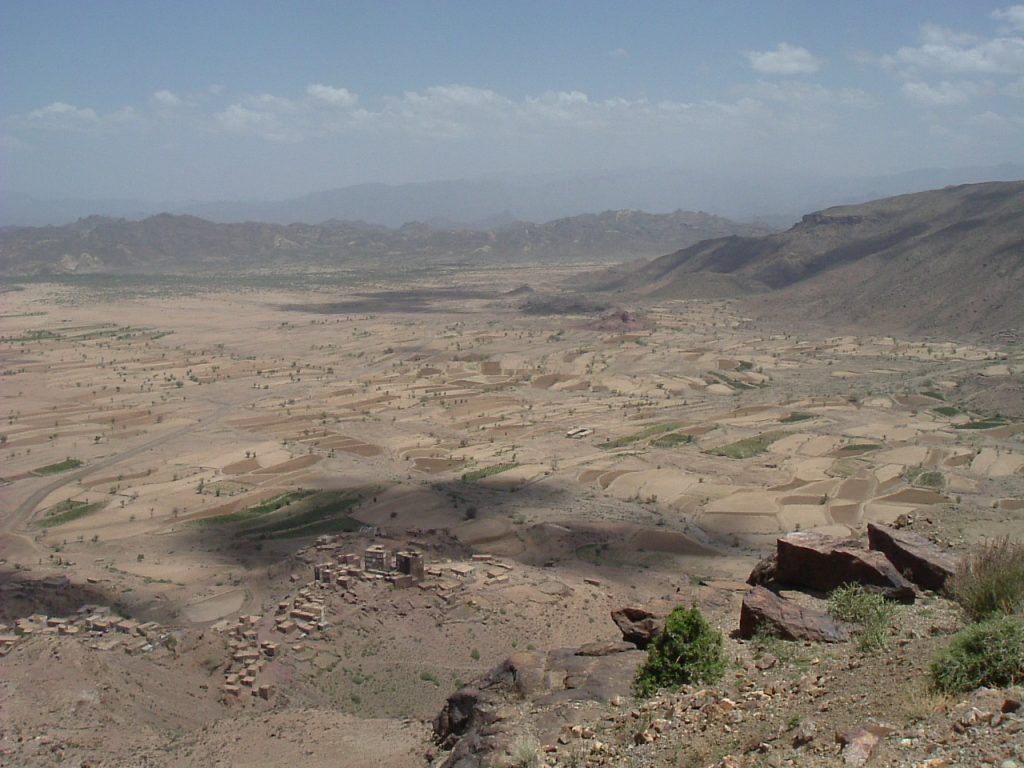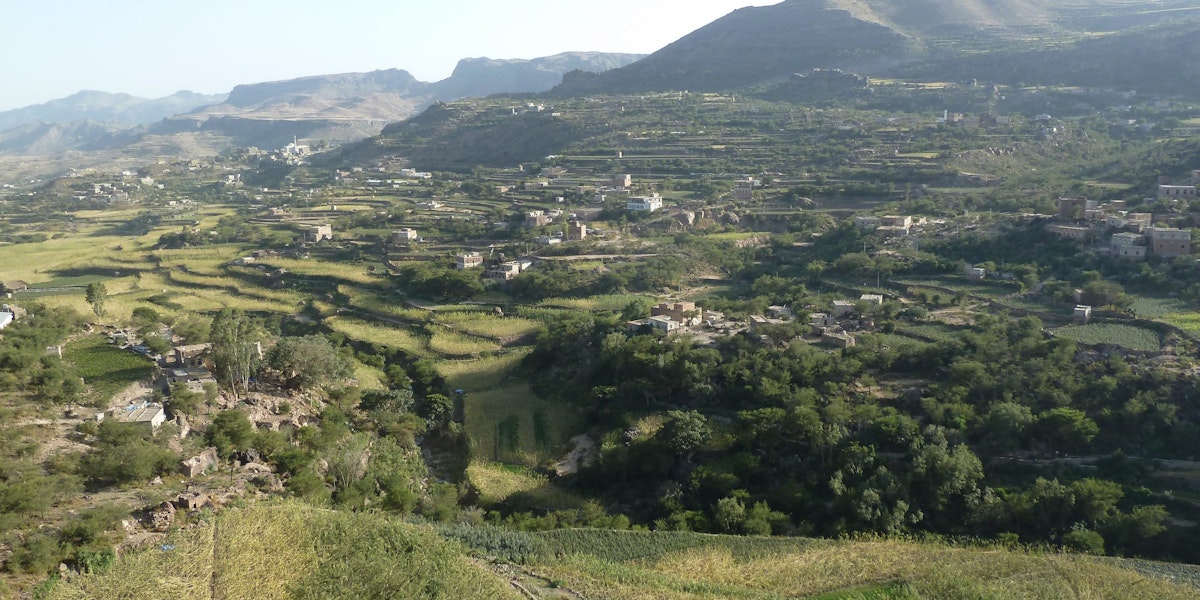The current civil war in Yemen threatens the country as a state, but the lesser-known environmental crisis threatens the very existence of Yemen as a habitable land. The civil war, which started in 2015, has produced the world’s worst humanitarian crisis.1 Civilians are caught between, on the one hand, the Houthi rebels and, on the other, the Yemeni government, various rival groups, and their Gulf Arab sponsors. In addition to more than 110,000 directly war-related deaths since 2014, including close to 13,000 civilians, an unrecorded much higher number of people have died from starvation.2
The startling suffering of Yemenis has largely gone unnoticed by world media. And even when that suffering has received press, an important but indirect root cause of the war has been all but ignored in international media and policy-making circles: a long-term environmental catastrophe.
Alongside other poor countries around the world, Yemen suffers disproportionately from the consequences of wealthy states’ continued carbon emissions—even as Yemen itself is an insignificant contributor of global warming gases.3 As a prime producer of harmful emissions and the most powerful state in the world, the United States has a responsibility to address the problems resulting, even partially, from the damage it is causing to the world’s environment. Yemen should be a focus of U.S. concern, not only as its population of nearly 30 million is suffering, but also because it is in the American geostrategic interest. Millions of Yemenis may, in the future, be forced to migrate to neighboring states, particularly Saudi Arabia, should life become impossible in their homeland because of climate-related events. The political and strategic importance of Saudi Arabia’s stability for the United States is widely acknowledged, and Washington’s main, direct concern in Yemen is counterterrorism. Both these risks are aggravated by Yemen’s environmental problems, in particular its water crisis.
Environmental issues demonstrate the complex synergy between factors directly resulting from human intervention and other apparently “natural” phenomena—“acts of God.” Debate in recent decades about mutual causality between environmental degradation and conflict has focused on Sudan’s Darfur and northeastern Syria. The situation in Yemen confirms that the nexus exists, but is indirect: for example, during the past four decades, depletion of the aquifer in the Sa’ada basin in the far north of the country accelerated social differentiation. Wealthy landowners drilled deep wells to irrigate high-value fruit crops, while the majority of smallholders were impoverished, as their shallow wells dried up and they lost their own agricultural and pastoral potential.
This situation created fertile ground for the rise of the Houthi movement, which presented itself as a popular response to the actions of a kleptocratic elite. Elsewhere in Yemen, following the exhaustion of their water supplies, families forced out of their villages increase pressure on resources in the towns to which they migrate. In the past three decades or so, these and other developments contributed to social and political tension, which eventually boiled over into a series of smaller and then larger-scale open conflicts.
The only aspect of the war’s impact that could be seen as positive has been the rapid spread of solar power for domestic use, which has electrified some households for the first time, and replaced the highly erratic national network elsewhere.
In the short term, the war’s environmental impact has been complex: There is no doubt about the totally negative impact on people or the environment of mines, unexploded munitions, and other war debris. Destruction of physical infrastructure is affecting education, medical services, and access to basic necessities for a largely rural population. The only aspect of the war’s impact that could be seen as positive has been the rapid spread of solar power for domestic use, which has electrified some households for the first time, and replaced the highly erratic national network elsewhere. Solar power has also been used for irrigation systems, also with some benefits: unlike more powerful diesel pumps, solar pumps cannot reach the deepest fossil aquifers, and their impact on the environment is thus more limited.
In antiquity, Yemen was known to geographers by the Latin name “Arabia Felix”—“Fertile Arabia”—thanks to the fertility of its western mountains, where rain-fed agriculture thrived. In the past century, a number of factors—caused by human intervention, both local and direct, and international and indirect—have led to a major environmental crisis, dramatically exacerbated by political instability in recent decades and, now, full-scale war. Water scarcity is the main manifestation of these problems. The shortage is better publicized in urban areas, but it is most prominent in rural areas, where 70 percent of the population lives. While water scarcity is Yemen’s most pressing environmental problem, other environmental issues are closely interconnected.
The Challenge
Both short-term and long-term environmental crises loom over Yemen. The most urgent and best-publicized environmental issue in Yemen is the threat posed by a neglected oil tanker floating off the west coast of the country. The supertanker Safer is moored about eight kilometers west of Ras Isa on the Red Sea, and may leak its massive cargo of crude oil into the ocean. It has not received any maintenance since Houthi rebels captured it in 2015. If it sinks or explodes, it will cause a historic environmental catastrophe.4 A release of the supertanker’s 1.148 million barrels of oil would be a spill four times the size of the 1989 Exxon Valdez disaster in Alaska, destroying marine life and human livelihoods on a massive scale. The damage would take decades to recover from, and would impact the entire Red Sea region and all the countries bordering it—but would be most extreme for Yemen itself.
Even longer-brewing problems in Yemen are starting to have immediate consequences. In Yemen, climate change is not a distant prospect. Catastrophic climate events that are “unprecedented” or statistically “once-in-a-century” are now frequent.5 Among numerous recent examples are two major cyclones within a week in 2015, another two in 2018, and a series of destructive nationwide downpours and floods in 2020, all causing irreparable damage to different aspects of Yemen’s wonderful heritage and people. Thousands of unique endemic species in the UNESCO-listed Socotra archipelago were uprooted, and the foundations of hundreds of historic buildings in the city of Sana’a and elsewhere collapsed or were undermined.6
There are other environmental issues, besides inland water use, that need to be considered. Some result from the internationally dominant neoliberal economic paradigm, with policies that prioritize private profits over the health and welfare of populations. In Yemen, this has meant the increased privatization of medical services and education and the concentration of wealth under the control of a small elite of regime beneficiaries. These are problems that are not unique to Yemen, but for which the country, like many developing nations, has paid a disproportionate price.

Rising sea levels (due to global warming) have increased the salinity of aquifers near the coast, causing deterioration of the water supply of three of the country’s major cities, as well as agricultural production on the coastal plains, which have the country’s best soils.7 Fisheries, a major potential economic resource for Yemenis, have already suffered enormously from unregulated overfishing, depleting important species (such as rock lobster), in some cases possibly to levels from which they cannot recover.8 Although artisanal fisheries have played a part in this depletion, the main damage has come from large-scale international fleets illegally fishing within Yemen’s exclusive economic zone. Lack of state enforcement of regulations is an important factor in this process.
Similarly, official neglect of health and safety precautions has contributed to widespread water and air pollution from the side effects of hydrocarbon extraction inland, in the fragile natural environments of Shabwa, Marib, and Hadhramaut. People in nearby settlements complain of unusually high rates of cancer and other previously unknown or rare diseases.9
The effect of climate change on Yemen—and the world—is undeniable. In 2010, the World Bank forecast three main possible scenarios for Yemen, the most likely being “hot and dry” and “warm and wet.”
“Yemen will be getting warmer, most likely at a faster rate than the global average,” the Bank predicted. “There will be more variability of rainfall patterns within years [and] there will probably be an increased frequency of intense rainfall events and therefore possibly an increased risk of floods.”10
Overall, temperatures in Yemen have increased by 1.8 degrees Celsius in the past fifty years. With a wide range of regional variations, the Intergovernmental Panel on Climate Change forecasts average temperature increases of 2.3 degrees by 2060, with heat waves lasting longer.11 Rainfall currently ranges from less than 50 mm to 750 mm per year, and is unevenly distributed, to the detriment of the areas dependent on rain-fed agriculture.12 The predicted increase in rainfall and temperatures in the temperate highland zone is not expected to reduce dependence on imports of basic staples; instead, it is likely to cause significant yield reductions.13
Moreover, desertification of existing agriculture (currently affecting 3–5 percent of land annually) will persist or worsen.14 Land degradation and deforestation have simultaneously intensified the climate change process and been intensified by it, reducing agricultural and pastureland for decades. Topsoil is washed or blown away, and trees and bushes die from drought.
Daily “routine” environmental issues for Yemenis are directly and indirectly related to both water and human action. For decades, Yemen has annually extracted one-third more water than is sustainable. In 2010, for example, 3.5 billion cubic meters (bcm) were consumed, but only 2.1 bcm replenished. The 1.4 bcm shortfall was pumped from nonrenewable fossil aquifers.15 In 2010, the World Bank estimated that groundwater reserves would be depleted by about 2040.16 Other estimates give earlier deadlines. As in many other countries, 90 percent of water is used in agriculture.
In 2010, the World Bank estimated that groundwater reserves would be depleted by about 2040. Other estimates give earlier deadlines.
Nationally, the per capita availability of renewable water was just 95 cubic meters in 2018. It is expected to decrease to as little as 55 cubic meters by 2031, well below the 500 cubic meters that is the threshold for “absolute water scarcity,” according to the Falkenmark Indicator, a common measure of water stress.17 Compounding the problem of scarcity is that the distributions of water aquifers and population density are the opposite in Yemen; thus, the most populated areas have the least access to groundwater.
There are three main reasons for water scarcity. The first is rapid population growth, averaging 3 percent a year. The second is the introduction of diesel-operated pumps during the twentieth century, and deep-well drilling technology for irrigation (the area irrigated by wells increased from 37,000 hectares in the 1970s to more than 400,000 in the first decade of this century).18 The third reason for water scarcity is changing rainfall patterns, with increasingly violent downpours further reducing replenishment, as the loss of topsoil prevents absorption of flows, particularly where terraces have deteriorated due to lack of maintenance.
In the first years of the Republic of Yemen, formed in 1990, government water strategy could at best be described as “benign neglect.” Later, the government issued a series of water policy documents, many of which were instigated by foreign development agencies. After years of procrastination, the Water Law was promulgated in 2002, and its bylaws issued in 2011. The nine-year gap between the promulgation and the issuance of the bylaws revealed the intensity of debate over control of water. Despite the new legal framework, the Ministry of Water and Environment (established in 2003) and the National Water Resources Authority (established in 1995) remained largely powerless, regardless of their official authority and responsibilities.19
In any case, the Water Law was actually made toothless within months of its promulgation, when responsibility for the irrigation sector was returned to the Ministry of Agriculture and Irrigation, the institutional home of large landowners. Policies promoted by the main international financiers, particularly the World Bank, were in harmony with the regime of Ali Abdullah Saleh, and supported powerful rural leaders. (Saleh was president from 1990 until his ouster in 2012.) They financed irrigation for export crops, leading to unregulated drilling and overextraction of fossil aquifers. This encouraged the absurd situation where one of the world’s most water-scarce countries exported its water—albeit indirectly, through the crops it sold.20 Contrary to project policies, much deep-well irrigation was used to cultivate qat, a plant with narcotic properties that is legal and widely used in Yemen: qat cultivation consumes up to 30 percent of the water in the highlands.21 Funders and the government alike neglected the rain-fed agricultural sector on which millions depend for survival.
Consequently, water shortages worsened, with increasingly frequent conflicts over both agricultural and domestic supplies. Villages were evacuated as their water sources dried up. As popular awareness of the seriousness of the situation developed, frustration at state inaction combined with other sources of anger to bring about the 2011 uprisings and demands for better governance. As is all too often the case, the most vulnerable—such as women and the rural poor—are the most burdened. Their workloads increase as they collect water. Meanwhile, Yemen suffers from insufficient financial and technical resources to recover from climate disasters.

Urban water supplies were problematic long before the war started. Sana’a has, for decades, been described as the first world capital likely to run out of water. But the crisis has been far deeper in Taiz, Yemen’s third-largest city, where, twenty-five years ago, 40 percent of households connected to the public network were already only supplied with water once every thirty to sixty days.22 Decreased availability of water in Sana’a is noticeable.23 Until the late 1970s, water was found at a relatively shallow depth of 180 meters in the city, and nearby springs flowed in “falaj” (underground channels), filling cisterns supplying the old city.24 In the last decade, however, drilling to depths of 1,000 meters has failed to produce potable water. The city’s sewage system is failing due to an overload of biological matter, a clear sign of reduced water use.25 In Sana’a, even wealthy, newly built sections of the city are now excluded from the urban network, while those included get water once or twice a week. Two decades ago, in comparison, water was supplied daily.
Solutions
The urgency of addressing Yemen’s environmental problems, and particularly its water crisis, cannot be overemphasized. Yemen’s population is predicted to reach about 50 million by 2050.26 As water runs out, more people will move to towns, cities, and rural locations with more reliable supplies. Urban areas will need more water from neighboring aquifers, except along the coasts, where desalination must become the main source. With three of Yemen’s main cities and hundreds of fishing villages on the coast, rising sea levels also demand urgent attention and careful planning.
Forced migration to better-resourced areas will worsen pressure on limited natural resources, while competition for livelihoods and political space increases, with previously settled groups held together by greater social coherence, if not cohesion. A contemporary example of such social tensions is the hostility of southern separatists against “northerners.” While this is presented as a political conflict, its underlying reality is competition over access to inadequate services and insufficient jobs.27 Eventually, when the water crisis becomes unmanageable within Yemen itself, thousands will become climate refugees and, in desperation, head for neighboring countries—primarily Saudi Arabia and Oman—regardless of walls and other physical barriers, like the fence that Saudi Arabia has been building for several years. 28
Policies giving priority to domestic water supplies can prevent such disasters and must be implemented. Everywhere, this will necessitate enforced transfer of water usage from the agricultural sector to domestic use. To achieve this without creating social tension requires a highly sophisticated approach addressing different aspects, executed in synergy. These different aspects include the existing social relations; the topography; the nature and capacity of the water source; per capita availability; the most appropriate distribution mechanism to ensure sustainability (which may well be very different from the desires of the people dependent on the source); and a suitable sanitation infrastructure. The most difficult issue will be to find equitable mechanisms to supply cities from neighboring rural aquifers. Alternative sources of income must be provided for the rural people deprived of their agricultural water, including, for example, high-value, rain-fed agriculture. These rural dwellers must also receive physical and social infrastructure of the same quality as the cities.
Of course, given the fractured state of Yemeni politics and with the country still at war, no one is now in a position to achieve these types of large-scale policy changes. But a more intelligent policy toward Yemen from the United States and other international powers can begin to nudge the country in the right direction.
Widespread awareness of the water crisis and the long history of sophisticated community-based mechanisms to regulate the use of water are major assets in addressing the problem of scarcity. Customary law and Islamic precepts prioritizing drinking water for people and livestock over other uses—alongside a multiplicity of community-based regulations—must structure the solution, along with strong and equitable state enforcement. None of these fixes is sufficient on its own. Instead, they all have to operate together and complement each other. Education will be an important part of the solution. The issue of groundwater is complex, and the water itself is invisible to most people, most of the time. It is essential that awareness about the issues is raised at all levels—among the population as well as with officials.
Solutions to these and the other abovementioned environmental problems are similar: in brief, good governance. Yemeni institutions must have the capacity—and their agents the determination—to enforce the country’s exclusive maritime economic zone, to enable fishery stocks to recover and, later, to ensure they are sustainably harvested. Hydrocarbon extraction must be managed effectively, protecting both people and the natural environment from the health risks and dangers associated with the process of oil extraction. State enforcement, again, is a must.
Action cannot wait for the end of the war. The following essential interventions should start immediately.
- International multilateral agencies and states should, without delay, finance and commission research into high-value, rain-fed crops and drought-resistant, fast-maturing staple crops. Yemen’s Agricultural Research and Extension Authority and its regional branches are able to carry out such research by cooperating with small-scale farmers in the country’s different agro-ecological subzones to produce seeds and seedlings most likely to flourish in the different altitudes and soil conditions that exist in the country. Such advances would provide an immediate income for a few smallholders and prepare a future where rain-fed agriculture could sustain thousands—and therefore save them from forced migration and the further impacts of climate change.
- International agencies—such as the United Nations Food and Agriculture Organization (FAO), the International Fund for Agricultural Development, or the World Water Council—can finance participatory research and analysis identifying effective and consensual mechanisms for sustainable water management. Different customary mechanisms to resolve competition on water sources still exist: their principles and potential adjustments to the new problems need to be assessed and discussed to provide guidelines and to help people exchange experiences. This should primarily involve community members and customary water managers throughout the country, with a minor role for experts.
- International institutions can train Yemenis in environmental protection regulations and consensual enforcement mechanisms. The United States can contribute directly by financing this training.
- While the war is still ongoing, U.S. authorities should influence its allies, the United Arab Emirates and Saudi Arabia, by ensuring they improve their understanding of the implications of the long-term problems and risks of current negative trends. This would be an entry point for developing effective strategies to achieve genuine peace and prosperity in Yemen, focused on the well-being of the Yemeni population. Reducing frustration and the attractiveness of jihadist groups—such as al-Qaeda in the Arabian Peninsula and the Islamic State—is in the interest not only of the Yemeni population but also of its neighbors.
- While the Gulf Cooperation Council (GCC) states are likely to be the main external financiers of reconstruction efforts, their involvement should focus on the real needs of Yemen. The GCC states enjoy only limited popularity in Yemen, because of their role in the war. As such, it would be wiser for them to support reputable and well-managed Yemeni or international institutions to implement the abovementioned activities.
- The maritime blockade of Yemen, which began in 2015, can and should be transformed into a force to protect Yemen’s fisheries. The maritime military tools for such a force are already present, in both the Red Sea and the Arabian Sea, but have thus far been used to starve the country rather than to help it. The blockading states can immediately transition their activities to preventing illegal fishing, thus actually contributing positively to Yemen’s future survival.
Regional Cooperation Leads the Way
It is unlikely that a unified, centralized Yemeni state such as existed between 1990 and 2015 will be reestablished in Yemen in the foreseeable future. Recent social and political fragmentation indicates that the distribution of responsibilities and control between national and local authorities is likely to remain contentious for a while. It also implies persistent socioeconomic divergence. The country is likely to continue to suffer from the inequitable distribution of national assets, particularly given the imbalance between population density and the availability of natural resources, especially water. The creation of mechanisms for regional cooperation rather than rivalry is essential to restore peaceful cooperation among Yemenis, and between Yemenis and their powerful neighbors. Regional cooperation over environmental issues offers a promising place to begin: it is not overtly political, it will benefit everyone involved, and it could have knock-on benefits of cooperation in other areas.

Thanks to their new political assertiveness and perspectives, the current leaders of the funding GCC states are likely to model their support to Yemen on the experience of the Emirates, building ultramodern infrastructure, dependent on migrant labor, in a previously largely empty desert environment. This model is inappropriate in a very rural, highly populated, mountainous agricultural society. The prospect of Yemen being subjected to such policies is disturbing with respect to the future of its social, economic, and cultural characteristics. In addition to the livelihoods of millions, the cultural and architectural wealth of the country would be seriously threatened by such strategies. It would be wise for GCC decision-makers to accept that they should respect Yemen’s culture and history, rather than trying to transform the country in their own image. The influence of U.S. thinkers and institutions in this direction could contribute significantly to a more stable and prosperous Yemen, serving the needs of its citizens as well as regional stability—and indirectly strengthening American security.
This report was written with support from the Rockefeller Brothers Fund as part of the TCF initiative “Nature and National Security in the Middle East.”
header photo: Terraced fields in Wadi Bana, one of the wettest areas of Yemen. In recent years, torrential rains have eroded this traditional farming technique in parts of the country. Source: Helen Lackner.
Notes
- “Yemen: The World’s Worst Humanitarian Crisis,” World Food Programme, https://www.wfp.org/yemen-crisis.
- “ACLED Resources: War in Yemen,” Armed Conflict Location and Event Data Project (ACLED), https://acleddata.com/2020/03/25/acled-resources-war-in-yemen/.
- In 2009, Yemen had a per capita consumption of 190 kilowatt hours (kWh), compared to a world average of 2,751 kWh. See “Mocha Wind Farms Project Appraisal Document,” World Bank report no. PAD651, February 11, 2014, 2, http://documents1.worldbank.org/curated/en/156751468335513164/pdf/PAD6510P146055010Box382145B00OUO090.pdf.
- “Without Access to Stricken Oil Tanker off Yemen, Under-Secretary-General, Briefing Security Council, Warns of Environmental, Economic, Humanitarian Catastrophe,” United Nations Security Council press release, July 15, 2020, https://www.un.org/press/en/2020/sc14254.doc.htm.
- “Future Impact of Climate Change Visible Now in Yemen,” World Bank, November 24, 2014, http://www.worldbank.org/en/news/feature/2014/11/24/future-impact-of-climate-change-visible-now-in-yemen.
- “Socotra, the Galapagos of the Indian Ocean, Becomes a Disaster Zone,” BBC, May 24, 2018, https://www.bbc.com/news/world-middle-east-44235159.
- “Yemen—Assessing the Impacts of Climate Change and Variability on the Water and Agricultural Sectors and the Policy Implications,” World Bank report no. 54196-YE, 2010, https://openknowledge.worldbank.org/handle/10986/2943.
- Angelo Bonfiglioli and Khaled Ibrahim Hariri, “Small-Scale Fisheries in Yemen: Social Assessment and Development Prospects,” World Bank, 2004, https://agris.fao.org/agris-search/search.do?recordID=GB2013201176.
- Saleh Mohammed Altamimi, Radieah Mohd Nor, and Mohd Sayuti Hassan, “Impact of Oil Wells Drilling Process on Human Health in Hadhramout, Yemen,” International Journal of Academic Research in Business and Social Studies 9, no. 12 (2019): 924–39, https://hrmars.com/papers_submitted/6831/impact-of-oil-wells-drilling-process-on-human-health-in-hadhramout-yemen.pdf.
- World Bank, “Yemen—Assessing the Impacts of Climate Change,” 20.
- “Climate Change Profiles: Yemen,” Netherlands Ministry of Foreign Affairs, 2019, https://www.government.nl/documents/publications/2019/02/05/climate-change-profiles.
- “Climate Risk Profile: Yemen,” United States Agency for International Development (USAID), 2016, 2, https://www.climatelinks.org/resources/climate-change-risk-profile-yemen.
- World Bank, “Yemen—Assessing the Impacts of Climate Change.”
- “Strategic Program for Climate Resilience for Yemen, Meeting of the PPCR Sub-Committee,” Climate Investment Funds, April 17, 2012, 42, https://www.climateinvestmentfunds.org/sites/cif_enc/files/ppcr_8_strategic_program_for_climate_resilience_yemen_0_0.pdf.
- Christopher Ward, The Water Crisis in Yemen: Managing Extreme Water Scarcity in the Middle East (London: I.B. Taurus, 2014).
- World Bank, “Yemen—Assessing the Impacts of Climate Change,” 21.
- Chris White, “Understanding Water Scarcity: Definitions and Measurements,” Global Water Forum, May 7, 2012, https://globalwaterforum.org/2012/05/07/understanding-water-scarcity-definitions-and-measurements/.
- Alvar Closas and Francois Molle, “Groundwater Governance in the Middle East and North Africa,” IWMI project report no. 1, https://www.researchgate.net/publication/318825306_Groundwater_governance_in_the_Middle_East_and_North_Africa_region.
- Helen Lackner, “Water Scarcity: Why Doesn’t It Get the Attention It Deserves?,” in Why Yemen Matters: A Society in Transition, (London: Saqi Books, 2014), 164–76.
- Such an indirect water export is also known as “virtual water,” a concept developed by the scholar Tony Allan. See Kaitlin Stack Whitney and Kristoffer Whitney, “John Anthony Allan’s ‘Virtual Water’: Natural Resources Management in the Wake of Neoliberalism,” Arcadia, Spring 2018, http://www.environmentandsociety.org/arcadia/john-anthony-allans-virtual-water-natural-resources-management-wake-neoliberalism.
- Ward, The Water Crisis in Yemen, 81–82.
- Helen Lackner, Yemen in Crisis: Autocracy, Neo-Liberalism and the Disintegration of a State (London: Saqi Books, 2017), 221.
- Taha Taher et al., “Local Groundwater Governance in Yemen: Building on Traditions and Enabling Communities to Craft New Rules,” Hydrogeology Journal 20, no. 6 (2012): 1177–88.
- Personal observation of the author.
- Fadhl Ali Al-Nozaily, Fath Khidhr Radhwan, Abdulwahab Ismael Salah, “Evaluation of Wastewater Treatment Plant in Sana’a, Yemen,” Journal of Science and Technology 11 (2006), https://ust.edu/ojs/index.php/JST/article/view/65.
- Helen Lackner, “The Future of Yemen,” Global Policy, May 1, 2017, https://www.globalpolicyjournal.com/blog/01/05/2017/future-yemen.
- Diana Alghoul, “Yemen’s UAE-Backed Southern Secessionists Are Expelling Northern Refugees as They Move to Seize Aden,” The New Arab, August 12, 2019, https://english.alaraby.co.uk/english/indepth/2019/8/12/yemens-uae-backed-southern-secessionists-are-expelling-northern-refugees; Lackner, Yemen in Crisis, pp. 185–6.
- “Saudi Arabia Builds Giant Yemen Border Fence,” BBC, April 9, 2013, https://www.bbc.com/news/world-middle-east-22086231.











